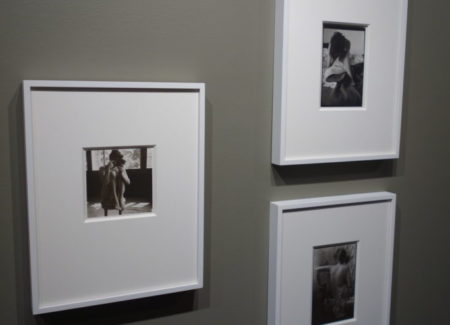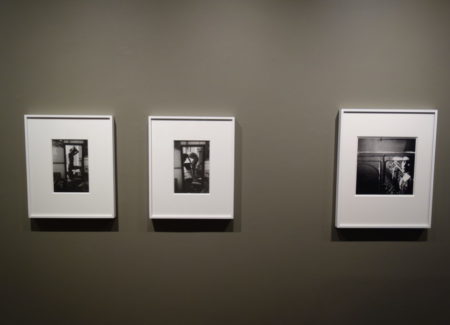JTF (just the facts): A total of 39 black and white photographs, framed in white and matted, and hung against olive colored walls in the second gallery space. All of the works are gelatin silver prints, made between c1946 and c1960, some printed at the time and others printed c1970s or more generally later. Physical sizes range from roughly 5×4 to 11×16 inches (or the reverse), and no edition information was provided on the checklist. 10 of the prints have been overpainted with gouache, casein, and watercolor, modifying the dates to range from the 1970s to the 1990s. (Installation shots below.)
A monograph of this body of work has been published by Steidl (here).
Comments/Context: When artists die, it is often the case that they leave behind an unexpected mountain of work that never really made it out of the studio or the storage boxes. These can be ideas that were started but never fully fleshed out, projects left unfinished, threads that were followed but then abandoned, and plenty of works that were left on the cutting room floor, so to speak, edited out or overlooked for one reason or another. It generally becomes the task of the estate (or associated gallery) to meticulously sift through all of these materials in the subsequent years, trying to make sense of what remains or perhaps discover notable images or bodies of work that got lost in the shuffle, in the hopes of clarifying and cementing the artist’s legacy.
Saul Leiter died in 2013, and part of what was unearthed in his archive after his death was a selection of black and white nudes that he took between the mid 1940s and the early 1960s. Largely made within the intimate confines in his East Village studio, the photographs were to become the raw material for a 1970s book project that never actually came to fruition. So while Leiter has come to be best known for this work on the streets of New York (particularly in color), this exhibit (and the accompanying monograph) brings us into the interior rooms of his studio, where his contemplative images of various female models take on a more wistful tone.
For so many of the mid 20th century male photographers who made nude photographs of female subjects, the interaction between the artist and sitter was either aloof and often objectifying (ultimately abstracting a body into lines, curves, and forms) or voyeuristic (sometimes blatantly, sometimes not), both of which set up subtle structures of power. So what’s particularly intriguing about Leiter’s rediscovered nudes is that they are generally neither of these, and the tendency toward invisible control is entirely absent. The images settle into a distance that is close and comfortable without being intrusive, resolutely personal without being leering, and immediate and present without being aggressive. And they consistently nestle into moments of real attention and connection between artist and muse, where a look or a small gesture feels collaborative and trusting, even when it reveals vulnerability or solitude.
The prevailing mood in Leiter’s nudes is one of unassuming ease, where various models (Inez, and Barbara, and Soames, and Jay, and others) lounge around the apartment, on rumpled beds and couches, or move into the bathroom to wash up or change clothes. Bathed in natural light and indirect shadows, the scenes never feel staged or particularly arranged, aside from a bent arm placed just so or a gesture held for effect; mostly the models seem to quietly inhabit the space, as though engaged in a wandering conversation that makes room for extended silences. Leiter’s presence is active and close without being overbearing, and the consistent eye contact between the artist and his muses is evidence that both sides were always paying close attention, regardless of the comfort and familiarity of the situation.
The relaxed languor of these pictures takes the pressure off of making too much of clever compositional devices Leiter is trying out. When he shoots into a mirror, catching a model bending over the tub, tying up her hair, or laying on the bed lost in thought, we mostly see the naturalness of the gestures rather than the double framing effects or studied reflections. The same can be said for views of Inez removing her shirt, or Barbara picking something out of her eye, or Soames standing underneath a wet towel – Leiter is capturing small moments of everyday intimacy, but he’s doing so without being wholly intrusive. Other pictures return to recurring themes and motifs, as if looking for something graceful and subtle to be found in the drapery of a nightgown or a wrinkled sheet, the darkness of a silhouette or a view from the back, or the weary gesture of two hands wiping or covering the eyes.
When he moves in closer, the pictures inevitably become eye-to-eye exchanges or tightly cropped portraits, unless the model has diffused the directness of the interaction by turning to take a drag of a cigarette or look inward for a moment. None of Leiter’s models seems particularly afraid of a bold stare or a stark connection, and there are plenty of memorable images of these kinds of visual dialogues to be found in this show. While the nuanced emotions on display are largely inscrutable, flickers of personalities slip through the in between spaces, making the pictures all the more personal.
Later in his life, Leiter reworked many of these nudes by overpainting them, and a selection of his mixed-media works finds him making these encounters even more impressionistic and diffuse. Washes of color inhabit backgrounds and dappled spots and specks of paint decorate faces, transforming the naturalness of the photographs into essences and analogies, the specific named people now dissolving into more elemental investigations of the simplicity of form.
The understated mystery and gentle charm found in Leiter’s nudes makes them the kind of pictures many will overlook – they keep their secrets close and divulge them only reluctantly. And while these images do travel terrain we have seen before in other interior nude studies, the best of Leiter’s nude photographs have a sense of caring and understanding that pushes them from the personal to the universal. There is true fondness in Leiter’s eye, and that warmth burnishes even the most mundane of apartment room setups.
Collector’s POV: The prints in this show range in price from $8000 to $32000, with one print NFS. Leiter’s work has begun to enter the secondary markets in the past few years. Recent prices have ranged between roughly $2000 and $25000.


















I’m working on my collection of Saul Leiter prints.
Could you offer prints, signed by Saul Leiter?